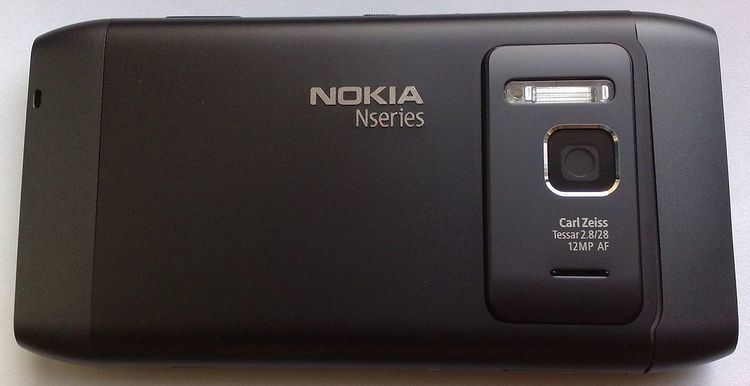 | ||
Slogan What will you do with it? Compatible networks HSDPA (Pentaband) HSUPA 850 / 900 / 1700 / 1900 / 2100Quad band GSM / GPRS / EDGE GSM 850, GSM 900, GSM 1800, GSM 1900 Predecessor Nokia N97Nokia N86 8MP | ||
The Nokia N8 is a touchscreen-based smartphone developed by Nokia. The Nokia N8 was the first device to run on the Symbian^3 mobile operating system and Nokia's flagship device of 2010. It was released on 30 September 2010 at the Nokia Online Store before being released in markets around the world on 1 October 2010. The N8 features a 12-megapixel camera, the second time a camera of such megapixel count was used (the first one being the Sony Ericsson Satio back in 2009), and a pentaband 3.5G radio. Among the connectivity features are an HDMI output, USB On-The-Go, and Wi-Fi 802.11 b/g/n.
Contents
- History
- Body
- Display
- Hardware
- Power and related information
- Data and connectivity
- Operating frequency
- Sensors
- Software platform and user interface
- Applications
- Email and messaging
- Browsing and Internet
- Navigation
- Camera
- Image capture
- Video cameras
- Video sharing and playback
- Music
- Accessories
- Development support
- Promotion
- References
History
The previous phone in the Nseries was the N97, which was criticised for its initial firmware issues. Anssi Vanjoki, Nokia's Executive Vice President for Markets, said in an interview that software quality control would be better than for the N97. The N8 was the first device to feature the Symbian^3 operating system. Initially scheduled for the second quarter of 2010, the N8 was pushed back to the third quarter, being finally released on 30 September 2010 due to 'final amendments'. The N8 became the product with the most customer pre-orders in Nokia's history up to the point of its release and sales in Q4 2010 were estimated to be almost 4 million.
The previous Nokia phone with a focus on photography had been the N86 8MP, which has an 8-megapixel sensor and had become available on June 2009.
The N8 was the second Nokia to have a capacitive touchscreen, following the X6, and the first with multi-touch.
Body
Display
Hardware
Power and related information
The Nokia N8 has dual charging options, allowing it to be charged both from a standard-pin Nokia charger, and through the micro-USB port.
The Nokia N8's battery compartment is internally contained and thus the battery is not entirely straightforwardly removable or replaceable by users. Nonetheless, although the procedure is not endorsed by Nokia, it is possible with the correct tool and careful handling to change the battery.,
BL-4D 1200 mAh Lithium-ion battery.
Data and connectivity
Operating frequency
Sensors
Software platform and user interface
The N8 was the first Nokia smartphone device to run on the Symbian^3 operating system.
From 7 February 2012, Nokia Belle update was available for N8 through Nokia Suite. In August of that year, Nokia also started to roll out the Nokia Belle Refresh update. This update brought new features to the Symbian Smartphone like HTML 5 web apps support and a new set of home screen widgets.
Other software which will function on the N8 smartphone:
Applications
Email and messaging
The Anna operating system update gave Communicator support (which is usually reserved for E-Series devices). There was also a new push notification API and a corresponding app.
Browsing and Internet
Proprietary web browser (latest version 7.4.2.6 in Belle v.111.030.0609 official firmware), including:
Navigation
Camera
Image capture
Video cameras
The video-capturing feature is complemented by the mini HDMI port located on the top side of the phone, which normally mirrors the phone's screen, but allows for applications (such as the built-in video player, the Nokia Big Screen app and selected games) to output content in resolutions up to 720p. The corresponding cable is provided in the retail box in most regions.
Video sharing and playback
Music
Accessories
The Nokia Mobile TV Headset provides DVB-H TV.
Development support
Applications can be developed using the Nokia Qt framework.
Promotion
To highlight the capabilities of the Nokia N8 camera, Nokia created a short film, The Commuter, in October 2010. Directed by the McHenry brothers and starring Dev Patel, Ed Westwick, Charles Dance and Pamela Anderson, the seven-minute film was shot entirely on the phone's 720p camera. For the Spanish promotion of the phone they also created a short video featuring luminescent puppets, called "[www.techfashy.com/2014/11/nokia-launches-their-first-android_18.html Love Knot]".
The phone was also used to film Drums of Death's "Won't Be Long" music video.
Using CellScope technology, Nokia also released another film called "Dot" which they marketed to as the world's smallest stop-motion animation character.
The device also appeared on the popular Showtime TV show, Dexter, and the BBC TV series Hustle, as well as the film, TRON: Legacy. It is also the phone Sarah Lund uses in the third series of The Killing..
In Asian countries, it was promoted differently through the fictional character Pier Roxas on Nokia's Project Gener8 by Young & Rubicam Philippines. He also appeared on the GMA talk show Startalk to promote the device.
The "Nokia Shorts 2011" competition involved 8 Short films shot on a Nokia N8. The winner was "Splitscreen: A Love Story".
The independent film Olive, which is the first feature-length film of about 90 minutes to be made entirely with a cell phone, uses the Nokia N8 along with an old fashioned video camera attachment with a 35 mm lens made exclusively for the device and to trick the audience by not realizing it was made from the Nokia N8.
